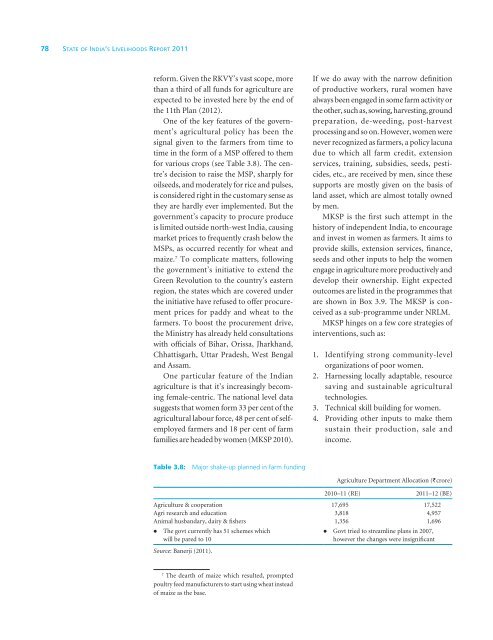SOIL Report 2011 - ACCESS Development Services
SOIL Report 2011 - ACCESS Development Services
SOIL Report 2011 - ACCESS Development Services
- No tags were found...
Create successful ePaper yourself
Turn your PDF publications into a flip-book with our unique Google optimized e-Paper software.
78 State of India’s Livelihoods <strong>Report</strong> <strong>2011</strong>reform. Given the RKVY’s vast scope, morethan a third of all funds for agriculture areexpected to be invested here by the end ofthe 11th Plan (2012).One of the key features of the government’sagricultural policy has been thesignal given to the farmers from time totime in the form of a MSP offered to themfor various crops (see Table 3.8). The centre’sdecision to raise the MSP, sharply foroilseeds, and moderately for rice and pulses,is considered right in the customary sense asthey are hardly ever implemented. But thegovernment’s capacity to procure produceis limited outside north-west India, causingmarket prices to frequently crash below theMSPs, as occurred recently for wheat andmaize. 7 To complicate matters, followingthe government’s initiative to extend theGreen Revolution to the country’s easternregion, the states which are covered underthe initiative have refused to offer procurementprices for paddy and wheat to thefarmers. To boost the procurement drive,the Ministry has already held consultationswith officials of Bihar, Orissa, Jharkhand,Chhattisgarh, Uttar Pradesh, West Bengaland Assam.One particular feature of the Indianagriculture is that it’s increasingly becomingfemale-centric. The national level datasuggests that women form 33 per cent of theagricultural labour force, 48 per cent of selfemployedfarmers and 18 per cent of farmfamilies are headed by women (MKSP 2010).If we do away with the narrow definitionof productive workers, rural women havealways been engaged in some farm activity orthe other, such as, sowing, harvesting, groundpreparation, de-weeding, post-harvestprocessing and so on. However, women werenever recognized as farmers, a policy lacunadue to which all farm credit, extensionservices, training, subsidies, seeds, pesticides,etc., are received by men, since thesesupports are mostly given on the basis ofland asset, which are almost totally ownedby men.MKSP is the first such attempt in thehistory of independent India, to encourageand invest in women as farmers. It aims toprovide skills, extension services, finance,seeds and other inputs to help the womenengage in agriculture more productively anddevelop their ownership. Eight expectedoutcomes are listed in the programmes thatare shown in Box 3.9. The MKSP is conceivedas a sub-programme under NRLM.MKSP hinges on a few core strategies ofinterventions, such as:1. Identifying strong community-levelorganizations of poor women.2. Harnessing locally adaptable, resourcesaving and sustainable agriculturaltechnologies.3. Technical skill building for women.4. Providing other inputs to make themsustain their production, sale andincome.Table 3.8: Major shake-up planned in farm fundingAgriculture Department Allocation (`crore)2010–11 (RE) <strong>2011</strong>–12 (BE)Agriculture & cooperation 17,695 17,522Agri research and education 3,818 4,957Animal husbandary, dairy & fishers 1,356 1,696• The govt currently has 51 schemes whichwill be pared to 10Source: Banerji (<strong>2011</strong>).• Govt tried to streamline plans in 2007,however the changes were insignificant7The dearth of maize which resulted, promptedpoultry feed manufacturers to start using wheat insteadof maize as the base.














